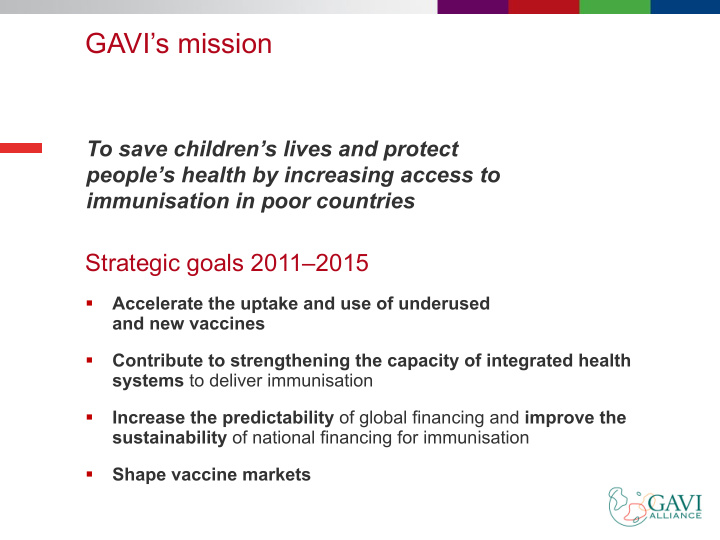



GAVI’s mission To save children’s lives and protect people’s health by increasing access to immunisation in poor countries Strategic goals 2011–2015 ! Accelerate the uptake and use of underused and new vaccines ! Contribute to strengthening the capacity of integrated health systems to deliver immunisation ! Increase the predictability of global financing and improve the sustainability of national financing for immunisation ! Shape vaccine markets
The power of partnership: the GAVI Alliance Board
What countries have achieved with GAVI support ! Immunised 326 million Future deaths averted children ! Prevented over 5.5 million future deaths ! Accelerated vaccine introductions in over 70 countries ! Strengthened health systems to deliver immunisation ! Helped shape the market Source: These estimates and projections are produced by the WHO Department of Immunization, Vaccines and Biologicals, based on the most for vaccines up-to-date data and models available as of 30 September 2011. *Includes deaths averted by GAVI-supported vitamin A supplementation programmes.
Accelerating Hepatitis B vaccine introduction in low-income countries Source: WHO, Vaccine introduction database 4
Driving equity in vaccine access Routine use of vaccines in high- and low-income countries Hepatitis B Source: WHO, Vaccine introduction database.
GAVI support 2000-2011 Source: GAVI Alliance 2012
Increased competition reduces vaccine price Price decline of pentavalent vaccine and number of manufacturers Source: UNICEF Supply Division, 2012
Pentavalent vaccine - 5 in one shot - diptheria tetanus pertussis hep B and hib Approved for pentavalent vaccine support 2000 – April 2012 Source: GAVI Alliance data as of 13 April 2012
China hepatitis B vaccine success story ! US$ 76 million project equally funded by GAVI and the Government of China ! Aim: accelerate integration of hep B vaccine into EPI and ensure injection safety ! Focus: W. China and poor areas in Central China ! Results: 2001-2009 in project counties ! Hep B 3 coverage - 40% to 95% increase ! Hep B at birth coverage - 50% to 88% increase ! 90% use of autodisable syringes ! Carrier rate in children under 5 dropped 10% to 1% ! Catalytic: Government fully funding Hep B vaccines
� rop in chronic carrier rate between 1979 - 2006 !!!!!!!!!!!!Prevalence!of!HBsAg!in!age!groups!surveyed!in!the!year!of!1979,!1992!&!2006! 12.00 10.00 HBsAg (%) � 8.00 6.00 1979 1 � 4 � 0.96% � 4.00 5 � 14 � 2.42% � 1992 15 � 59 � 8.57% � 2006 2.00 0.00 1~4 5~9 10~14 15~19 20~24 25~29 30~34 35~39 40~44 45~49 50~54 55~49 Age Group (year) � Courtesy: Dr Cui Fuqiang 1.Qu Z. An epidemiological study on the distribution of HBsAg and anti-HBs in China. Chine Journal of Microbiogy Immunology. 1986; Suppl(20-40). 2.Dai ZC, G.M. Q. Seroepidemiological Survey in Chinese population (part one), 1992–1995. Beijing. Sci Tech Exp. 1996: 39-59. 3.Liang X, Bi S, Yang W, Wang L, Cui G, Cui F, et al. Epidemiological serosurvey of hepatitis B in China--declining HBV prevalence due to hepatitis B vaccination. Vaccine. 2009; 27(47): 6550-7. !
India: Pentavalent vaccine introductions 2011– 2012 Introduced 2011 Introductions 2012 Courtesy: WHO and UNICEF, India 11
Thank you UNICEF/2006/Josh Estey
13
Hepatitis B price decline Source: UNICEF Supply Division, 2010
Recommend
More recommend